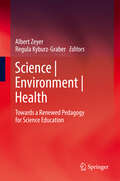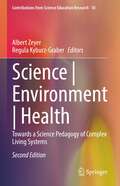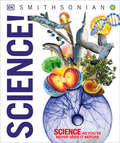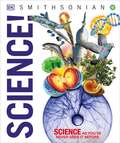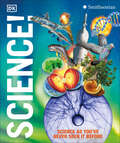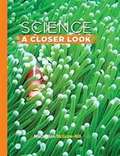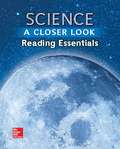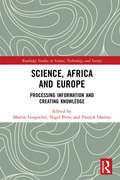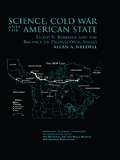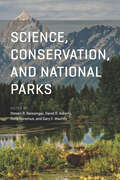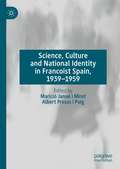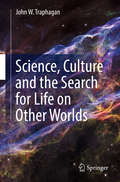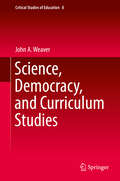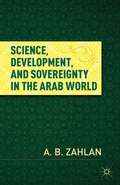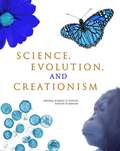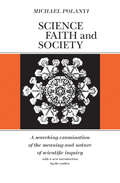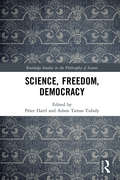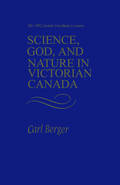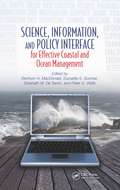- Table View
- List View
Science | Environment | Health: Towards a Renewed Pedagogy for Science Education (Contemporary Trends and Issues in Science Education)
by Albert Zeyer Regula Kyburz-GraberHealth and the environment are important learning areas in science education and their significance is growing. Not only do they have high social relevance, but they are also close to students' interests and needs. They provide many opportunities to unlock science with questions that are personally relevant to boys and girls and that inspire them to engage in science. This book contains a selection of papers from prominent professionals in science, health and environmental education, who reflect on science education, each from their specific point of view. The core idea is to present well-founded perspectives on how science education may benefit from challenges stemming from both health and environmental education. Specific reasons are discussed as to why these two areas are particularly legitimized to challenge science education, and their potential impact on a revision of science education is evaluated. A new pedagogy for science¦environment¦health that yields interesting and relevant science education for students and teachers, and addresses the grand challenges of this century: what an attractive and rewarding project! The book will motivate teachers, teacher educators and science education researchers to take part in this on-going project.
Science | Environment | Health: Towards a Science Pedagogy of Complex Living Systems (Contributions from Science Education Research #10)
by Albert Zeyer Regula Kyburz-GraberThis book provides a fascinating insight into the on-going process of self- reflection in the Science|Environment|Health (S|E|H) community. The basic vision of a new S|E|H pedagogy is to establish a transdisciplinary dialogue between the three educational fields of science education, environmental education, and health education. This approach finds growing interest among science educators. Since 2014, the ESERA special interest group S|E|H has united both experienced and junior researchers all over Europe in a burgeoning research community.This book presents a selection of results of these vibrant activities. Systems theory has turned out to be a stimulating theoretical framework for S|E|H. The limits of predictability in complex living systems result in structural uncertainty for decision-making, and they ask for emphasising and rethinking the role of pedagogical concepts like informed citizenship and scientific literacy. They challenge crude scientific determinism in environmental and health education, which all too often ends up with students’ eco- and health depression. Instead, S|E|H conceives coping with uncertainty in terms of an interplay between cognitive and affective factors. The horizon of the future remains always open. Hope must never die in a new S|E|H pedagogy.Chapter 3 is available open access under a Creative Commons Attribution 4.0 International License via link.springer.com.
Science! (DK Knowledge Encyclopedias)
by DKExplore science as you&’ve never known it before with this children's encyclopedia perfect for budding scientists!Forming part of a fantastic series of kid's educational books, this bold and brilliant kid's encyclopedia uses ground-breaking CGI imagery to reveal the world as you've never seen it before. Informative, diverse in subject matter, easy-to-read and brimming with beautiful graphics, young learners can explore the incredibly detailed cross-sections and cutaways that reveal the scientific inner workings of just about everything!This charming children&’s encyclopedia opens the world in new ways, with: - Packed with facts, charts, timelines, and infographics that cover a vast range of topics. - Encompassing a visual approach with illustrations, photographs and extremely detailed 3D images.- Crystal clear text distills the key information.- DK's encyclopedias are fact-checked by subject experts to offer accuracy beyond online sources of information.This fully-updated edition of Knowledge Encyclopedia Science! is the perfect encyclopedia for children aged 9-12, ideal for inquisitive minds, providing young readers with an engaging introduction to core science topics, demonstrating how all the major scientific principles fit together and using awe-inspiring illustrations to reveal how biology, chemistry and physics is used every day in the world around us. Jam-packed with spectacular scientific facts, including graphics, facts, and data boxes, this science encyclopedia is sure to delight budding young scientists. Explore, Discover And Learn!DK's Knowledge Encyclopedia Science! uncovers the marvels of our world in unprecedented detail and with stunning realism. Encompassing incredible computer-generated images to reveal and explain science as never before, you can spend quality time exploring the world of science with your children, whether it&’s looking inside a cell, pulling apart a Formula 1 racing car, or examining the forces that hold the Universe together, accompanied by impressive visuals to engage their senses. A must-have volume for curious kids with a thirst for knowledge, this enthralling encyclopedia is structured in such a way that your child can read a bit at a time, and feel comfortable to pause and ask questions. Doubling up as the perfect gift for young readers, who are always asking questions about the inner workings of our planet! At DK, we believe in the power of discovery. This thrilling kid&’s encyclopedia is part of the Knowledge Encyclopedia educational series. Celebrate your child&’s curiosity as they complete the collection and discover diverse facts about the world around them. Dive into the deep blue with Knowledge Encyclopedia Ocean! Travel back in time to when dinosaurs roamed the earth with Knowledge Encyclopedia Dinosaur! And hone your knowledge on how the human body works with Knowledge Encyclopedia Human Body! Whatever topic takes their fancy, there&’s an encyclopedia for everyone!
Science! (Knowledge Encyclopedias)
by DkForming part of a fantastic series of kid's educational books, this bold and brilliant kid's encyclopedia uses ground-breaking CGI imagery to reveal the world as you've never seen it before. Informative, diverse in subject matter, easy-to-read and brimming with beautiful graphics, young learners can explore the incredibly detailed cross-sections and cutaways that reveal the scientific inner workings of just about everything!
Science!, 2nd Edition (DK Knowledge Encyclopedias)
by DKDK’s best-selling richly illustrated encyclopedia series explores the wonderful world of science.Learn the ins and outs of science as you’ve never seen it before, through incredibly detailed 3D illustrations, in this encyclopedia for children aged 9+.Knowledge Encyclopedia’s clear explanations, illustrations, photographs, and 3D images will engage children in complex subjects. Learn about hundreds of vehicles that float, fly, or speed across the land, including the record breakers—the fastest, largest, longest, and strangest modes of transportation ever to zoom, sail, or soar.This all-encompassing science encyclopedia for kids offers: An impressive collection of facts, charts, timelines, and illustrations.A visual approach using illustrations, photographs, and extremely detailed 3D CGI images.Clear explanations of physics, chemistry, and biology, as well as space exploration, the latest technology, wonderful wildlife, and our amazing bodies.Children can explore science in a new and exciting way. Learn about groundbreaking topics like looking inside a cell, pulling apart the ever-present electronics in our lives to see how they work, showing how ships stay afloat, and examining the forces that hold the Universe together. This impressively detailed encyclopedia uses awesome illustrations to show biology, chemistry, and physics in the world around us. All the essential information in easy-to-read text with additional fun facts, and brought to life with amazing 3D illustrations that look inside the anatomy of a blue whale, zoom into a molecule of water, and out of the Solar System.More in the seriesKnowledge Encyclopedia Science! is part of DK’s visual and hugely successful Knowledge Encyclopedia series. Complete the collection and dive into the deep with Knowledge Encyclopedia Ocean!, take a trip to the solar system with Knowledge Encyclopedia Space! and travel back to prehistoric times with Knowledge Encyclopedia Dinosaur!
Science, Social Science class 6 - Tamil Nadu Board
by Tamil GovernmentThe Science textbook for standard six has been prepared following the guidelines given in the National Curriculum Framework 2005. The book is designed to maintain the paradigm shift from the primary General Science to branches as Physics, Chemistry, Botany and Zoology.
Science, A Closer Look (Elementary Science Closer Look Ser. #3)
by McGraw-Hill EducationThe Grade 3 Student Edition covers units such as Ecosystems, Earth and Its Resources, Matter, and Forces of Energy.
Science, A Closer Look, Grade 6, Reading Essentials
by McGraw-Hill EducationReading Essentials provides an ‘interactive’ reading experience to improve student comprehension of science content. It makes lesson content more accessible to struggling students and supports goals for differentiated instruction.
Science, Africa and Europe: Processing Information and Creating Knowledge (Routledge Studies in Science, Technology and Society)
by Patrick Harries Martin Lengwiler Nigel PennHistorically, scientists and experts have played a prominent role in shaping the relationship between Europe and Africa. Starting with travel writers and missionary intellectuals in the 17th century, European savants have engaged in the study of nature and society in Africa. Knowledge about realms of the world like Africa provided a foil against which Europeans came to view themselves as members of enlightened and modern civilisations. Science and technology also offered crucial tools with which to administer, represent and legitimate power relations in a new global world but the knowledge drawn from contacts with people in far-off places provided Europeans with information and ideas that contributed in everyday ways to the scientific revolution and that provided explorers with the intellectual and social capital needed to develop science into modern disciplines at home in the metropole. This book poses questions about the changing role of European science and expert knowledge from early colonial times to post-colonial times. How did science shape understanding of Africa in Europe and how was scientific knowledge shaped, adapted and redefined in African contexts?
Science, Cold War and the American State (Routledge Studies in the History of Science, Technology and Medicine)
by Allan A. NeedellThis book illuminates how Berkner became a model that produced the scientist/advisor/policymaker that helped build post-war America. It does so by providing a detailed account of the personal and professional beliefs of one of the most influential figures in the American scientific community; a figure that helped define the political and social climates that existed in the United States during the Cold War.
Science, Comprehensive Course 2
by Patricia Craig Juli Berwald Michelle Anderson John F. Bolzan Rachel ClarkNIMAC-sourced textbook
Science, Conservation, and National Parks
by Gary E. Machlis David D. Ackerly Holly Doremus Steven R. BeissingerAs the US National Park Service marks its centennial in 2016, parks and protected areas worldwide are under increasing threat from a variety of factors, including storms and fires of greater severity, plant and animal extinctions, the changing attitudes of a public that has become more urbanized, and the political pressures of narrow special interest groups. In the face of such rapid environmental and cultural changes, Science, Conservation, and National Parks gathers a group of renowned scholars—including Edward O. Wilson, Jane Lubchenco, Thomas Dietz, and Monica Turner, among many others—who seek to address these problems and, in so doing, to secure a future for protected areas that will push forward the frontiers of biological, physical, and social science in and for parks. Examining the major challenges of parks and protected areas throughout the world, contributors provide answers to a number of key conservation questions, such as: How should stewardship address climate change, urban encroachment and pollution, and invasive species? How can society, especially youth, become more engaged with nature and parks, and are there models to guide interactions between parks and their neighbors? What are appropriate conservation objectives for parks in the Anthropocene? Charting a course for the parks of the next century, Science, Conservation, and National Parks is certain not only to catalyze the continued evolution of US park conservation policy, but also to be an inspiration for parks, conservation, and management worldwide.
Science, Culture and National Identity in Francoist Spain, 1939–1959
by Marició Janué i Miret Albert Presas i PuigThis book examines the role that science and culture held as instruments of nationalization policies during the first phase of the Franco regime in Spain. It considers the reciprocal relationship between political legitimacy and developments in science and culture, and explores the ‘nationalization’ efforts in Spain in the 1940s and 1950s, via the complex process of transmitting narratives of national identity, through ideas, representations and homogenizing practices. Taking an interdisciplinary approach, the volume features insights into how scientific and cultural language and symbols were used to formulate national identity, through institutions, resource distribution and specific national policies. Split into five parts, the collection considers policies in the Francoist ‘New State’, the role of women in these debates, and perspectives on the nationalization and internationalization efforts that made use of scientific and cultural spheres. Chapters also feature insights into cinema, literature, cultural diplomacy, mathematics and technology in debates on Catalonia, the Nuclear Energy Board, the Spanish National Research Council, and how scientific tools in Spain in this era fed into wider geopolitics with America and onto the UNESCO stage.
Science, Culture and the Search for Life on Other Worlds
by John W. TraphaganThis book explores humanity's thoughts and ideas about extraterrestrial life, paying close attention to the ways science and culture interact with one another to create a context of imagination and discovery related to life on other worlds. Despite the recent explosion in our knowledge of other planets and the seeming era of discovery in which we live, to date we have found no concrete evidence that we are not alone. Our thinking about life on other worlds has been and remains the product of a combination of scientific investigation and human imagination shaped by cultural values--particularly values of exploration and discovery connected to American society. The rapid growth in our awareness of other worlds makes this a crucial moment to think about and assess the influence of cultural values on the scientific search for extraterrestrial life. Here the author considers the junction of science and culture with a focus on two main themes: (1) the underlying assumptions, many of which are tacitly based upon cultural values common in American society, that have shaped the ways researchers in astrobiology and SETI have conceptualized the nature of their endeavor and represented ideas about the potential influence contact might have on human civilization, and (2) the empirical evidence we can access as a way of thinking about the social impact that contact with alien intelligence might have for humanity.
Science, Democracy, and Curriculum Studies (Critical Studies of Education #8)
by John A. WeaverIn this book John A. Weaver suggests curriculum studies scholars need to engage more in science matters. It offers a review of science studies writing from Ludwick Fleck and Thomas Kuhn to Philip Mirowski. The volume includes chapters on the rhetoric of science with a focus on the history of rhetoric and economics then on the rhetoric of models, statistics, and data, a critique of neoliberalism and its impact on science policy and the foundations of democracy, Harry Collin’s and Robert Evans’ theory of expertise followed by chapters on feminism with a focus on the work of Sharon Traweek, Karen Barad, and Vinciane Despret, postcolonial thought, with attention paid to the work of Daniela Bleichmar, Londa Schiebinger, Judith Carney, Sylvia Wynter, Paul Gilroy, and Sandra Harding, and a final chapter on Nietzsche’s philosophy of science. Each section is introduced by an interlude drawing on autobiographical connections between curriculum studies and science studies.
Science, Development, and Sovereignty in the Arab World
by A. B. ZahlanZahlan's detailed study examines recent and current performance of Arab countries and their organizations in scientific research in relation to their socio-economic development. It shows that the Arab countries are severely handicapped by a political economy dominated by technological dependence, corruption, and limited research collaboration.
Science, Evidence, and Inference in Education: Report of a Workshop
by National Academy PressThe National Academies Press (NAP)--publisher for the National Academies--publishes more than 200 books a year offering the most authoritative views, definitive information, and groundbreaking recommendations on a wide range of topics in science, engineering, and health. Our books are unique in that they are authored by the nation's leading experts in every scientific field.
Science, Evolution And Creationism
by Institute of Medicine National Academy Of SciencesHow did life evolve on Earth? The answer to this question can help us understand our past and prepare for our future. Although evolution provides credible and reliable answers, polls show that many people turn away from science, seeking other explanations with which they are more comfortable. In the book Science, Evolution, and Creationism, a group of experts assembled by the National Academy of Sciences and the Institute of Medicine explain the fundamental methods of science, document the overwhelming evidence in support of biological evolution, and evaluate the alternative perspectives offered by advocates of various kinds of creationism, including "intelligent design." The book explores the many fascinating inquiries being pursued that put the science of evolution to work in preventing and treating human disease, developing new agricultural products, and fostering industrial innovations. The book also presents the scientific and legal reasons for not teaching creationist ideas in public school science classes. Mindful of school board battles and recent court decisions, Science, Evolution, and Creationism shows that science and religion should be viewed as different ways of understanding the world rather than as frameworks that are in conflict with each other and that the evidence for evolution can be fully compatible with religious faith. For educators, students, teachers, community leaders, legislators, policy makers, and parents who seek to understand the basis of evolutionary science, this publication will be an essential resource.
Science, Faith and Society
by Michael PolanyiIn its concern with science as an essentially human enterprise, Science, Faith and Society makes an original and challenging contribution to the philosophy of science. On its appearance in 1946 the book quickly became the focus of controversy. Polanyi aims to show that science must be understood as a community of inquirers held together by a common faith; science, he argues, is not the use of "scientific method" but rather consists in a discipline imposed by scientists on themselves in the interests of discovering an objective, impersonal truth. That such truth exists and can be found is part of the scientists' faith. Polanyi maintains that both authoritarianism and scepticism, attacking this faith, are attacking science itself.
Science, Faith and Society: A searching examination of the meaning and nautre of scientific inquiry
by Michael PolanyiIn its concern with science as an essentially human enterprise, Science, Faith and Society makes an original and challenging contribution to the philosophy of science. On its appearance in 1946 the book quickly became the focus of controversy. Polanyi aims to show that science must be understood as a community of inquirers held together by a common faith; science, he argues, is not the use of "scientific method" but rather consists in a discipline imposed by scientists on themselves in the interests of discovering an objective, impersonal truth. That such truth exists and can be found is part of the scientists' faith. Polanyi maintains that both authoritarianism and scepticism, attacking this faith, are attacking science itself.
Science, Fiction, and the Fin-de-Siècle Periodical Press (Cambridge Studies in Nineteenth-Century Literature and Culture)
by Will TattersdillIn this revisionary study, Will Tattersdill argues against the reductive 'two cultures' model of intellectual discourse by exploring the cultural interactions between literature and science embodied in late nineteenth-century periodical literature, tracing the emergence of the new genre that would become known as 'science fiction'. He examines a range of fictional and non-fictional fin-de-siècle writing around distinct scientific themes: Martian communication, future prediction, X-rays, and polar exploration. Every chapter explores a major work of H. G. Wells, but also presents a wealth of exciting new material drawn from a variety of late Victorian periodicals. Arguing that the publications in which they appeared, as well as the stories themselves, played a crucial part in the development of science fiction, Tattersdill uses the form of the general interest magazine as a way of understanding the relationship between the arts and the sciences, and the creation of a new literary genre. Provides analysis of some of H. G. Wells's most famous writings, showing them in an entirely new light when placed back in their periodical context Challenges the 'two cultures' model of intellectual discourse by exploring the cultural interactions between literature and science Proposes a new view of the importance of periodicals as a
Science, Freedom, Democracy (Routledge Studies in the Philosophy of Science)
by Péter HartlThis book addresses the complex relationship between the values of liberal democracy and the values associated with scientific research. The chapters explore how these values mutually reinforce or conflict with one another, in both historical and contemporary contexts. The contributors utilize various approaches to address this timely subject, including historical studies, philosophical analysis, and sociological case studies. The chapters cover a range of topics including academic freedom and autonomy, public control of science, the relationship between scientific pluralism and deliberative democracy, lay-expert relations in a democracy, and the threat of populism and autocracy to scientific inquiry. Taken together the essays demonstrate how democratic values and the epistemic and non-epistemic values associated with science are interconnected. Science, Freedom, Democracy will be of interest to scholars and graduate students working in philosophy of science, history of philosophy, sociology of science, political philosophy, and epistemology.
Science, God, and Nature in Victorian Canada: The 1982 Joanne Goodman Lectures
by Carl BergerProfessor Berger aims in this book to 'explore the rise, expression, and relative decline of the idea of natural history' in Canada, during the age of Victoria. Science, particularly natural science, was then accessible to the general public in a way scarcely imaginable today. Natural history societies were set up in a number of cities and provided a focus for the descriptive and collecting activities of amateurs and incipient professionals. These societies acted as social clubs and vehicles for self-improvement as well as providing excellent training for the amateur scientist. The Baconian assumptions that inspired the Victorian collectors and scientists were one of the major victims of the Darwinian revolution, and their demise brought about the gradual decline of the natural history societies. Professor Berger considers also the sense of wonder and reverence with which Victorian Canadians, like their British contemporaries, looked at the varieties and delights of nature. The British tradition of natural theology had a great impact on the pursuit of science in Victorian Canada, leading naturalists and poets alike to seek in the uncharted flora and fauna of their new land the handiwork of a benevolent God. The author examines the impact of the discoveries of Darwin on this tradition and on the relations between science and religion, as the creator and the act of creation became more and more distant in time and more tenuously connected to the world of nature around us.His study provides many rich insights into the practice and theory of natural history in an age when even a veteran politician could look back and recall, with understanding and in detail, the world of nature in the countryside of his youth.
Science, Information, and Policy Interface for Effective Coastal and Ocean Management
by Bertrum H. MacDonaldThis book provides a timely analysis of the role that information-particularly scientific information-plays in the policy-making and decision-making processes in coastal and ocean management. It includes contributions from global experts in marine environmental science, marine policy, fisheries, public policy and administration, resource management
